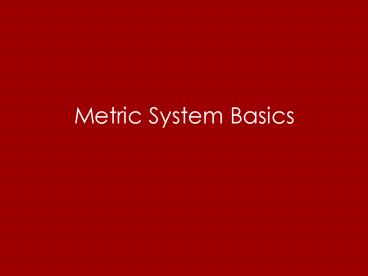Metric System Basics - PowerPoint PPT Presentation
1 / 16
Title:
Metric System Basics
Description:
Let's say you live approximately 10 miles from school. 10 miles = 16093 meters ... Now let's try our previous example from meters to kilometers: ... – PowerPoint PPT presentation
Number of Views:49
Avg rating:3.0/5.0
Title: Metric System Basics
1
Metric System Basics
2
Metric System
- The metric system is based on a base unit that
corresponds to a certain kind of measurement - Length meter
- Volume liter
- Weight (Mass) gram
- Prefixes plus base units make up the metric
system - Example
- Centi meter Centimeter
- Kilo liter Kiloliter
3
Metric System
- The three prefixes that we will use the most are
- kilo
- centi
- milli
4
Metric System
- So if you needed to measure length you would
choose meter as your base unit - Length of a tree branch
- 1.5 meters
- Length of a room
- 5 meters
- Length of a ball of twine stretched out
- 25 meters
5
Metric System
- But what if you need to measure a longer
distance, like from your house to school? - Lets say you live approximately 10 miles from
school - 10 miles 16093 meters
- 16093 is a big number, but what if you could add
a prefix onto the base unit to make it easier to
manage - 16093 meters 16.093 kilometers (or 16.1 if
rounded to 1 decimal place)
6
Metric System
- These prefixes are based on powers of 10. What
does this mean? - From each prefix every step is either
- 10 times larger
- or
- 10 times smaller
- For example
- Centimeters are 10 times larger than millimeters
- 1 centimeter 10 millimeters
7
Metric System
- Centimeters are 10 times larger than millimeters
so it takes more millimeters for the same length - 1 centimeter 10 millimeters
- Example not to scale
40
41
41
40
1 cm
8
Metric System
- For each step to right, you are multiplying
by 10 - For example, lets go from a base unit to centi
- 1 liter 10 deciliters 100 centiliters
- 2 grams 20 decigrams 200 centigrams
( 1 x 10 10) (10 x 10 100)
(2 x 10 20) (20 x 10 200)
9
Metric System
- An easy way to move within the metric system is
by moving the decimal point one place for each
step desired - Example change meters to centimeters
- 1 meter 10 decimeters 100 centimeters
- or
- 1.00 meter 10.0 decimeters 100. centimeters
10
Metric System
- Now lets try our previous example from meters to
kilometers - 16093 meters 1609.3 decameters 160.93
hectometers 16.093 kilometers - So for every step from the base unit to kilo,
we moved the decimal 1 place to the left (the
same direction as in the diagram below)
11
Metric System
- If you move to the left in the diagram, move the
decimal to the left - If you move to the right in the diagram, move the
decimal to the right
12
Metric System
- Now lets start from centimeters and convert to
kilometers - 400000 centimeters 4 kilometers
- 400000 centimeters 4.00000 kilometers
13
Metric System
- Now lets start from meters and convert to
kilometers - 4000 meters ____ kilometers
- Now lets start from centimeters and convert to
meters - 4000 centimeters _____meters
14
Metric System
- Now lets start from meters and convert to
centimeters - 5 meters ______ centimeters
- Now lets start from kilometers and convert to
meters - 1.3 kilometers _____ meters
15
Metric System
- Now lets start from kilometers and convert to
millimeters - 4 kilometers ________ millimeters
16
Metric System
- Summary
- Base units in the metric system are meter, liter,
gram - Metric system is based on powers of 10
- For conversions within the metric system, each
step is 1 decimal place to the right or left - Using the diagram below, converting to the right,
moves the decimal to the right and vice versa































